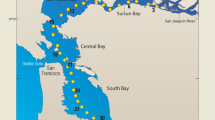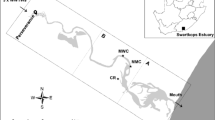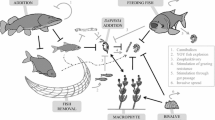Abstract
Anthropogenic nutrient loading from urbanised coastal watersheds can negatively impact downstream estuarine ecosystems. The urbanised and low-inflow Swartkops Estuary in South Africa is one such example of an ecosystem suffering severe anthropogenic water quality alterations. Substantial inorganic nutrient loads (209 kg DIN d−1; 127 kg DIP d−1) are discharged into the estuary from three upstream wastewater treatment works and an adjacent stormwater canal. As a result, previous studies have indicated an increasing frequency and magnitude of phytoplankton bloom conditions (> 20 µg Chl-a l−1), yet the determinants of this are not fully understood. As such, the drivers of phytoplankton community dynamics–including harmful algal blooms (HABs)–in the Swartkops Estuary were evaluated by investigating seasonal and twice-weekly data collected over a two-and-a-half-year period. Eutrophic levels of dissolved inorganic nitrogen (DIN: > 100 µM) and phosphorus (DIP: > 85 µM) entered the estuary throughout the study period. Despite low DIN:DIP ratios (< 1:1), high-biomass HABs of Heterosigma akashiwo (max. 2120 µg Chl-a l−1) and Cyclotella sp. (max. 687 µg Chl-a l−1) were frequently recorded in the meso- to polyhaline (salinity: 5–23) middle and upper reaches. These events facilitate extreme dissolved oxygen conditions (supersaturated to hypoxic), increased turbidity, and occasional mass fish mortality events. This shift to an undesirable alternate stable state is attributed to the synergistic interaction between drought conditions, altered hydrodynamics, and anthropogenic nutrient loading. Innovative management interventions (e.g. wastewater reclamation, constructed wetlands, dual nutrient reduction strategies) are required to reduce the severity of these eutrophic symptoms.






Similar content being viewed by others
References
Adams, J.B., D. Hughes, N. James, R. Kibble, D. Lemley, G. Rishworth, T. Riddin, N. Strydom, S. Taljaard, V. Tsipa, and L. Van Niekerk. 2021. Swartkops estuary: present ecological status and future restoration scenarios. Gqeberha, South Africa: Institute for Coastal and Marine Research, Nelson Mandela University Report No. 48.
Adams, J.B., L. Pretorius, and G.C. Snow. 2019. Deterioration in the water quality of an urbanised estuary with recommendations for improvement. Water SA 45: 86–96.
Adams, J.B., S. Taljaard, L. Van Niekerk, and D.A. Lemley. 2020. Nutrient enrichment threatens ecological resilience and health of South African microtidal estuaries. African Journal of Aquatic Science 45: 23–40.
Anderson, D.M., E. Fensin, C.J. Gobler, et al. 2021. Marine harmful algal blooms (HABs) in the United States: History, current status and future trends. Harmful Algae 102: 101975.
Bornman, E., J.B. Adams, and N.A. Strydom. 2022. Algal blooms of Heterosigma akashiwo and Mugilidae gill alterations. Estuaries and Coasts. https://doi.org/10.1007/s12237-021-01038-6.
Bornman, E., P.D. Cowley, J.B. Adams, and N.A. Strydom. 2021. Daytime intra-estuary movements and harmful algal bloom avoidance by Mugil cephalus (family Mugilidae). Estuarine, Coastal and Shelf Science 260: 107492.
Branco, S., M. Menezes, C. Alves-de-Souza, P. Domingos, M.A. Schramm, and L.A.O. Proença. 2014. Recurrent blooms of Heterosigma akashiwo (Raphidophyceae) in the Piraquê Channel, Rodrigo de Freitas Lagoon, southeast Brazil. Brazilian Journal of Biology 74: 529–537.
Bricker, S.B., B. Longstaff, W. Dennison, A. Jones, K. Boicourt, C. Wicks, and J. Woerner. 2008. Effects of nutrient enrichment in the nation’s estuaries: A decade of change. Harmful Algae 8: 21–32.
Buck, C.M., F.P. Wilkerson, A.E. Parker, and R.C. Dugdale. 2014. The influence of coastal nutrients on phytoplankton productivity in a shallow low inflow estuary, Drakes Estero, California (USA). Estuaries and Coasts 37: 847–863.
Carstensen, J., R. Klais, and J.E. Cloern. 2015. Phytoplankton blooms in estuarine and coastal waters: Seasonal patterns and key species. Estuarine, Coastal and Shelf Science 162: 98–109.
Cira, E.K., T.A. Palmer, and M.S. Wetz. 2021. Phytoplankton dynamics in a low-inflow estuary (Baffin Bay, TX) during drought and high-rainfall conditions associated with an El Niño event. Estuaries and Coasts 44: 1752–1764.
Cloern, J.E., and A.D. Jassby. 2010. Patterns and scales of phytoplankton variability in estuarine-coastal ecosystems. Estuaries and Coasts 33: 230–241.
Cloern, J.E., A.D. Jassby, T.S. Schraga, E. Nejad, and C. Martin. 2017. Ecosystem variability along the estuarine salinity gradient: Examples from long-term study of San Francisco Bay. Limnology and Oceanography 62: S272–S291.
Cloern, J.E., P.C. Abreu, J. Carstensen, et al. 2016. Human activities and climate variability drive fast-paced change across the world’s estuarine-coastal ecosystems. Global Change Biology 22: 513–529.
Department of Water and Sanitation (DWS), South Africa. 2022. Green Drop National Report 2022. Pretoria: Department of Water and Sanitation. https://ws.dws.gov.za/IRIS/latestresults.aspx. Accessed 1 Jun 2022.
Freeman, L.A., D.R. Corbett, A.M. Fitzgerald, D.A. Lemley, A. Quigg, and C.N. Steppe. 2019. Impacts of urbanization and development on estuarine ecosystems and water quality. Estuaries and Coasts 42: 1821–1838.
Glibert, P.M. 2017. Eutrophication, harmful algae and biodiversity – challenging paradigms in a world of complex nutrient changes. Marine Pollution Bulletin 124: 591–606.
Grasshoff, K., M. Ehrhardt, and K. Kremling. 1999. Methods of Seawater Analysis, 3rd ed. Weinheim, Germany: Wiley-VCH.
Griffith, A.W., and C.J. Gobler. 2020. Harmful algal blooms: A climate change co-stressor in marine and freshwater ecosystems. Harmful Algae 91: 101590.
Heisler, J., P.M. Glibert, J.M. Burkholder, et al. 2008. Eutrophication and harmful algal blooms: A scientific consensus. Harmful Algae 8: 3–13.
Helsel, D.R., and R.M. Hirsch. 2002. Statistical methods in water resources techniques of water resources investigations, 522. U.S. Geological Survey.
Jeong, H.J. 2011. Mixotrophy in red tide algae raphidophytes. Journal of Eukaryotic Microbiology 58: 215–222.
Kim, J.-H., B.S. Park, P. Wang, J.H. Kim, S.H. Youn, and M.-S. Han. 2015. Cyst morphology and germination in Heterosigma akashiwo (Raphidophyceae). Phycologia 54: 435–439.
Largier, J. 2010. Low-inflow estuaries: Hypersaline, inverse, and thermal scenarios. In Contemporary Issues in Estuarine Physics, ed. A. Valle-Levinson, 247–272. Cambridge: Cambridge University Press.
Largier, J.L., J.T. Hollibaugh, and S.V. Smith. 1997. Seasonally hypersaline estuaries in Mediterranean-climate regions. Estuarine, Coastal and Shelf Science 45: 789–797.
Lemley, D.A., and J.B. Adams. 2019. Eutrophication. In Encyclopedia of Ecology, 2nd ed., ed. B. Fath, 86–90. Oxford: Elsevier.
Lemley, D.A., and J.B. Adams. 2020. Physico-chemical and microalgal gradients change rapidly in response to mouth closure in a predominantly open estuary. African Journal of Aquatic Science 45: 11–21.
Lemley, D.A., C.P. Lakane, S. Taljaard, and J.B. Adams. 2022. Inorganic nutrient removal efficiency of a constructed wetland before discharging into an urban eutrophic estuary. Marine Pollution Bulletin 179C: 113727.
Lemley, D.A., J.B. Adams, and G.M. Rishworth. 2018a. Unwinding a tangled web: A fine-scale approach towards understanding the drivers of harmful algal bloom species in a eutrophic South African estuary. Estuaries and Coasts 41: 1356–1369.
Lemley, D.A., J.B. Adams, and N.A. Strydom. 2017. Testing the efficacy of an estuarine eutrophic condition index: Does it account for shifts in flow conditions? Ecological Indicators 74: 357–370.
Lemley, D.A., J.B. Adams, and N.A. Strydom. 2018b. Triggers of phytoplankton bloom dynamics in permanently eutrophic waters of a South African estuary. African Journal of Aquatic Science 43: 229–240.
Lemley, D.A., J.B. Adams, G.M. Rishworth, and D.A. Purdie. 2020. Harmful algal blooms of Heterosigma akashiwo and environmental features regulate Mesodinium cf. rubrum abundance in eutrophic conditions. Harmful Algae 100: 101943.
Lemley, D.A., J.B. Adams, T.G. Bornman, E.E. Campbell, and S.H.P. Deyzel. 2019. Land-derived inorganic nutrient loading to coastal waters and potential implications for nearshore plankton dynamics. Continental Shelf Research 174: 1–11.
Maguire, T.J., and R.W. Fulweiler. 2017. Fate and effect of dissolved silicon within wastewater treatment effluent. Environmental Science & Technology 51: 7403–7411.
Maúre, E.R., G. Terauchi, J. Ishizaka, N. Clinton, and M. DeWitt. 2021. Globally consistent assessment of coastal eutrophication. Nature Communications 12: 6142.
Murphy, J., and J.P. Riley. 1962. A modified single solution method for the determination of phosphate in natural waters. Analytica Chimica Acta 27: 31–36.
Nusch, E.A. 1980. Comparison of different methods for chlorophyll and phaeopigment determination. Archiv Für Hydrobiologie 14: 14–36.
Paerl, H.W., N.S. Hall, B.L. Peierls, and K.L. Rossignol. 2014. Evolving paradigms and challenges in estuarine and coastal eutrophication dynamics in a culturally and climatically stressed world. Estuaries and Coasts 37: 243–258.
Paerl, H.W., and J.T. Scott. 2010. Throwing fuel on the fire: synergistic effects of excessive nitrogen inputs and global warming on harmful algal blooms. Environmental Science & Technology 44 (20): 7756–7758.
Pinheiro, J., D. Bates, S. DebRoy, D. Sarkar, and R Core Team. 2018. nlme: linear and nonlinear mixed effects models. In R package version 3, 1–137.
Qin, Q., and J. Shen. 2017. The contribution of local and transport processes to phytoplankton biomass variability over different timescales in the Upper James River, Virginia. Estuarine, Coastal and Shelf Science 196: 123–133.
R Core Team. 2022. R: a language and environment for statistical computing. Vienna, Austria: R Foundation for Statistical Computing.
Rensel, J.E.J., N. Haigh, and T.J. Tynan. 2010. Fraser river sockeye salmon marine survival decline and harmful blooms of Heterosigma akashiwo. Harmful Algae 10: 98–115.
Scharler, U.M., and D. Baird. 2003. The influence of catchment management on salinity, nutrient stoichiometry and phytoplankton biomass of Eastern Cape estuaries, South Africa. Estuarine, Coastal and Shelf Science 56: 735–748.
Schettini, C.A.F., A. Valle-Levinson, and E.C. Truccolo. 2017. Circulation and transport in short, low-inflow estuaries under anthropogenic stresses. Regional Studies in Marine Science 10: 52–64.
Smit, T., D.A. Lemley, J.B. Adams, and N.A. Strydom. 2021. Fine-scale temporal changes in larval Gilchristella aestuaria (Family Clupeidae) and dominant zooplankton during recurrent estuarine harmful algal blooms. Estuarine, Coastal and Shelf Science 249: 107072.
Snow, G.C., G.C. Bate, and J.B. Adams. 2000. The effects of a single freshwater release into the Kromme Estuary. 2: Microalgal response. Water SA 26: 301–310.
Turpie, J.K., J.B. Adams, A. Joubert, et al. 2002. Assessment of the conservation priority status of South African estuaries for use in management and water allocation. Water SA 28: 191–206.
Van Niekerk, L., J.B. Adams, N.C. James, S.J. Lamberth, C.F. MacKay, J.K. Turpie, A. Rajkaran, S.P. Weerts, and A.K. Whitfield. 2020. An estuary ecosystem classification encompassing biogeography, size and types of diversity that supports estuarine protection, conservation and management. African Journal of Aquatic Science 45: 199–216.
Van Niekerk, L., J.B. Adams, S.J. Lamberth, C.F. MacKay, S. Taljaard, J.K. Turpie, S.P. Ewerts, and D.C. Raimondo. 2019. South African National Biodiversity Assessment 2018: Technical Report. Volume 3: Estuarine Realm. CSIR report number CSIR/SPLA/EM/EXP/2019/0062/A. Pretoria: South African National Biodiversity Institute Report Number: SANBI/NAT/NBA2018/2019/Vol3/A.
Van Niekerk, L., S. Taljaard, S.J. Lamberth, J.B. Adams, S.P. Weerts, and C.F. MacKay. 2022. Disaggregation and assessment of estuarine pressures at the country-level to better inform management and resource protection – the South African experience. African Journal of Aquatic Science. https://doi.org/10.2989/16085914.2022.2041388.
Walter, R.K., E.J. Rainville, and J.K. O’Leary. 2018. Hydrodynamics in a shallow seasonally low-inflow estuary following eelgrass collapse. Estuarine, Coastal and Shelf Science 213: 160–175.
Wang, Y., U. Naumann, S.T. Wright, and D.I. Warton. 2012. mvabund - an R package for model-based analysis of multivariate abundance data. Methods in Ecology and Evolution 3: 471–474.
Warton, D.I., S.T. Wright, and Y. Wang. 2012. Distance-based multivariate analyses confound location and dispersion effects. Methods in Ecology and Evolution 3: 89–101.
Warwick, R.M., J.R. Tweedley, and I.C. Potter. 2018. Microtidal estuaries warrant special management measures that recognise their critical vulnerability to pollution and climate change. Marine Pollution Bulletin 135: 41–46.
Wasserman, J., D.A. Lemley, and J.B. Adams. 2022a. Saltpan primary producer and inorganic nutrient dynamics in response to inundation with nutrient-rich water sources. Journal of Experimental Marine Biology and Ecology 551: 151723.
Wasserman, J., J.B. Adams, and D.A. Lemley. 2022b. Investigating the potential for saltpan restoration for the provision of multiple ecosystem services. African Journal of Aquatic Science. https://doi.org/10.2989/16085914.2022.2067823.
Wilson, J.R., F.P. Wilkerson, S.B. Blaser, and K.J. Nielsen. 2021. Phytoplankton community structure in a seasonal low-inflow estuary adjacent to coastal upwelling (Drakes Estero, CA, USA). Estuaries and Coasts 44: 769–787.
Zhang, Y., F. Fu, E. Whereat, K.J. Coyne, and D.A. Hutchins. 2006. Bottom-up controls on a mixed-species HAB assemblage: A comparison of sympatric Chattonella subsalsa and Heterosigma akashiwo (Raphidophyceae) isolates from the Delaware Inland Bays, USA. Harmful Algae 5: 310–320.
Zuur, A.F., E.N. Ieno, N.J. Walker, A.A. Saveliev, and G.M. Smith. 2009. Mixed effects models and extensions in ecology with R. New York: Springer.
Zuur, A.F., E.N. Ieno, and C.S. Elphick. 2010. A protocol for data exploration to avoid common statistical problems. Methods in Ecology and Evolution 1 (1): 3–14.
Acknowledgements
Opinions expressed and conclusions arrived at are those of the authors and do not necessarily represent the official views of the funding agencies. Dr Monique Nunes is thanked for providing the study site map. The Zwartkops Conservancy is also thanked for providing logistical support. We are grateful to the South African Environmental Observation Network (SAEON) Elwandle node for logistic assistance in the field and laboratory through the Shallow Marine and Coastal Research Infrastructure (SMCRI) programme.
Funding
This work is based on research financially supported by the Water Research Commission (Project: C2020/2021–00076), a Communities of Practice grant from the National Research Foundation (NRF) (GUN: 110612), and the DSI/NRF Research Chair in Shallow Water Ecosystems (UID: 84375). The Nelson Mandela University is thanked for providing postdoctoral fellowship funding to the lead author, Dr Daniel A. Lemley.
Author information
Authors and Affiliations
Corresponding author
Ethics declarations
Competing Interests
The authors declare no competing interests.
Additional information
Communicated by Hongbin Liu
Rights and permissions
Springer Nature or its licensor (e.g. a society or other partner) holds exclusive rights to this article under a publishing agreement with the author(s) or other rightsholder(s); author self-archiving of the accepted manuscript version of this article is solely governed by the terms of such publishing agreement and applicable law.
About this article
Cite this article
Lemley, D.A., Human, L.R.D., Rishworth, G.M. et al. Managing the Seemingly Unmanageable: Water Quality and Phytoplankton Dynamics in a Heavily Urbanised Low-Inflow Estuary. Estuaries and Coasts 46, 2007–2022 (2023). https://doi.org/10.1007/s12237-022-01128-z
Received:
Revised:
Accepted:
Published:
Issue Date:
DOI: https://doi.org/10.1007/s12237-022-01128-z




